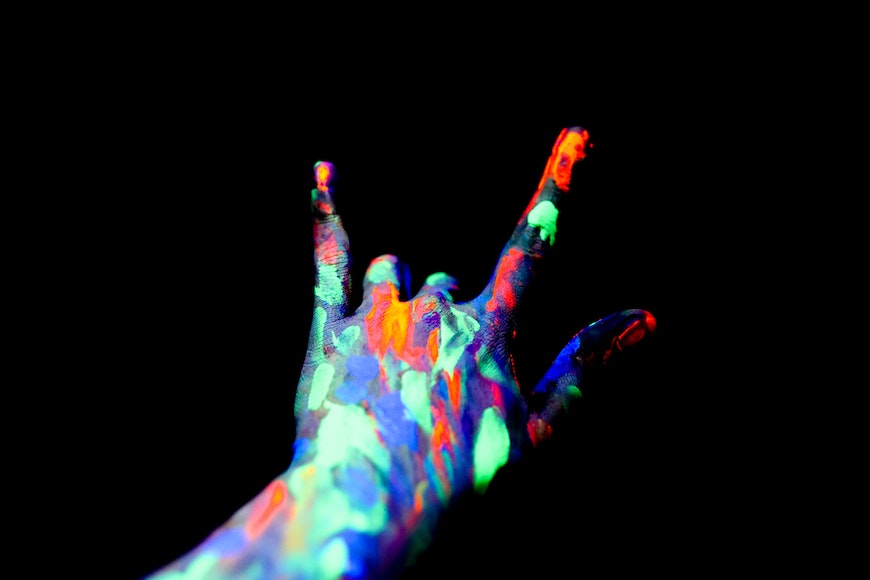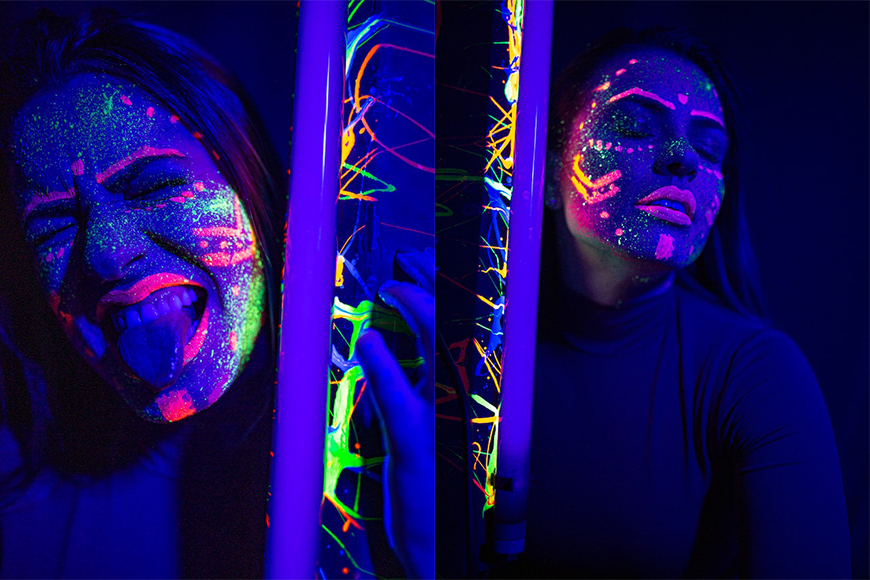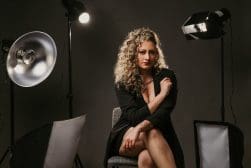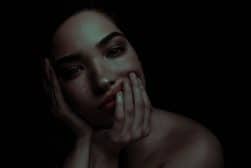
Getting Started in Black Light Photography
A step-by-step guide to black light photography, including what you need to get started, ideas, and tips and tricks for fantastic glow-in-the-dark photos.
Learn | Photography Guides | By Jeff Collier
If you’re looking to expand your photography skill set or simply need a break from regular landscape and portrait photography, black light photography is a medium worth exploring.
Also known as ultra-violet photography, or UV photography, black light photography is a style of photography that excludes visible light, instead leveraging UV lights to capture compelling content.
In this article, I’ll cover the ins and outs of black light photography, so let’s dive in.
What is Black Light Photography?

Credit: Alena Darmel
Ultraviolet (UV) light as a light source can be traced back to 1903 when it was first used by esteemed physicist and inventor, William Roberts Wood.
It was later used for medical procedures and dermatology before becoming an important part of legal photography and later, an artistic technique.
It’s believed to have first been used in the 1930s as a critical source of evidence in court photography — revealing marks and bruises that wouldn’t normally be visible otherwise.
More recently, black lights have been leveraged as a way to showcase art or capture real-life moments in a way that mimics a nightclub, though you can also use black light photography to take pictures in actual nightclubs.
How Does Black Light Photography Work?
Black light photography uses shorter wavelengths than the visible spectrum to highlight the subject.
You’ll want to incorporate things that are fluorescent under black light and absorb ultraviolet light, like neon makeup or clothing, to get the best illumination.
This style of UV photography offers a great way for both photographers and models to expand their portfolios with images, lighting and settings that go outside the box and beyond the visible light spectrum.
But getting great shots even in normal light can pose a challenge, so how do you do it with black light photography? Let’s discuss equipment first.
What Equipment Do I Need for Black Light Photography?

Credit: Soulful Pizza
To get started in UV photography, you don’t need a ton of expensive equipment. You mainly only need the right digital camera, lights and filter.
You’ll need to alter your camera settings and consider leaving time to practice trial and error to see what works best.
You can also get creative with things around the house to get the best results, including the right light bulb, nightclub lights, flashlights and UV black lights and light bulbs specifically designed for black light photography like the ones found here.
And while common household items can help you achieve great photos under ultraviolet light, let’s dive into the non-negotiables: the best cameras, filters, lights and backdrops for black light photography.
1. Camera
When it comes to black light photography, a DSLR digital camera is your best friend.
Basic settings offered by just about any DSLR or mirrorless camera can help you tremendously in mastering UV photography, so let’s dig deeper.
First, you’ll want to adjust the sensitivity of your camera sensor — a lower ISO equals less light sensitivity, while a higher ISO provides more sensitivity, which can be great for low-light photos!
I encourage you to play around with the level of sensitivity since that higher sensitivity setting can help you capture a solid picture in a dark place, but there’s a catch: it can also bring down the quality of your photo.
The aperture, or the opening in a lens that allows light to enter your camera, size is an important factor in photography.
Also known as the pupil of your camera, you can easily adjust it to expand or reduce its size to get the distance you want from the lens and the focal length your heart desires.
How Much Do You REALLY Know About Photography?! 🤔
Test your photography knowledge with this quick quiz!
See how much you really know about photography...

This gives you the freedom to transform the aperture from small to big or narrow to wide without a hassle.
You’ll see on your camera setting menu that the aperture is measured with an F — if a small number follows the F, you have a large or wide aperture, which lets more light in and helps you get a shallow depth of field with a crisp foreground.
A large number following F means you have a small or narrow aperture, which is perfect for snagging that sharper, deeper depth of field where everything in the photo appears vivid.
Your shutter speed is another essential function of your camera that controls the length of time your shutter stays open when you’re taking a picture.
Naturally, the longer your camera shutter stays open, the more light your camera receives and the clearer your photo is, so you’ll be relying on a slower shutter speed, which can make it very hard to get a high-quality photo you’re happy with.
Keep in mind that when leaning on slower shutter speeds and long exposures, you’ll need to ensure you have a stable hand to avoid distortion from movement.
See how to change your shutter speed >>
2. Filter
A bandpass filter can make a huge difference in the quality of your black light images.
This filter allows one or two wavelength bands to pass through while keeping others out.
To determine the best bandpass filter for your project needs, check out the detailed chart here, which helps you find the best filter based on the wavelength range.
3. Lights
Ideally, you’ll have a light source produced by big strip lights like the ones found here or a trusted LED lamp when trying your hand at black light photography.
You can replace the standard bulbs at home or in your studio with black light bulbs, but I highly recommend taking advantage of the higher wattage of the bar lights linked above.
This will provide you with the exposure flexibility and cool effects you need when shooting black light photography.
In a pinch, you can use a flashlight to meet some of your lighting needs when working on UV photography.
4. Backdrop
A neutral backdrop is a must-have for any portrait session – see more backdrops for photography.
And the go-to choice for blacklight photography is, of course, a black background in a dark room or darkened studio.
You can then tape black light strips to the backdrop or use a handy flashlight to help get the glow you want.
How to Do Black Light Photography: A Step-by-Step Guide

Credit: Lucas Pezeta
Whether you’re trying to replicate a vibrant nightclub atmosphere or trying to put a unique spin on some food and drinks, there are a few steps you can take to elevate your UV photography, so let’s get started.
Step 1: Choose Your Setting
Shooting indoors is preferred as the natural sunlight outside can overpower the black light effects you’re after.
Professional photographers will choose their studio, but you can create your own at home too, in any room!
You’ll want a dark space, so use the window treatments around you to block light and darken the room.
Then turn the lights off or temporarily replace the standard bulbs in your room with some of the black light bulbs I mentioned above, and you’ll have bold, fresh images in no time.
Step 2: Find Your Light
I’ve already touched on the importance of lighting, but this step cannot be underestimated!
Whether you use a black light lamp from Amazon, black light bulbs or some light strips, you’ll be able to play around with the light and see what works best to achieve your vision with as much light as you want.
You can also find a world of helpful tips for blacklight photography in the DIY-photography-based video above.
Step 3: Pick Your Speed
As noted under the camera section, you’ll want to make sure you pick the appropriate shutter speed.
You’ll need to select a slow shutter speed to pick up on the low level of light emitted by UV lighting.
Play around with long exposures of half a second or more to see what gives you the best results.
Step 4: Paint and Play
There’s a ton of ultraviolet-designed paint out there, so have fun playing around with different neon colors, paint and makeup to add a playful element to your black light photos.
11 Fun & Creative Black Light Photography Ideas

Credit: Jesus con S Silbada
Wondering what to photograph under ultraviolet light? I’ve got you covered!
1. Plants
Your subjects don’t have to just be people! Shine a UV lamp on any plants and home and you’ll get some artistic shots that illuminate their unique, funky shapes with the bright glow you covet.
2. Food
What’s more fun than a cake with neon icing?
You could even have your models, decked out in neon colors, start a food fight and get some amazing shots of them with glow sticks, UV-specific makeup and the cake lighting them up.
And if you’re the model, don’t worry! Just grab a tripod, set the timer and appropriate lighting, and start shooting.
3. Cocktails
Add a spooky touch to your cocktails or tonic water around Halloween! Just place a black light around your festive display and start snagging shots of these fun subjects.
4. Clothing
Pretty much anything neon will work, but you can also find some fun tights or t-shirts with eclectic patterns on Amazon.
5. Makeup
I touched on this already, but I can’t emphasize enough that UV light makeup is your best bet in achieving funky shots when participating in blacklight photography. You can also play around with UV face paint and body art.
6. Jewelry
Glow-in-the-dark earrings would make a stunning profile shot for social media even better, and a classic close-up of a glow-in-the-dark necklace would add interest to a standard portrait.
7. Candles
Whether you go back to the cake with neon icing idea and add some candles or create a fun candle crown to rock as headwear, you’ll have a blast using candles that shine under ultraviolet light.
8. Hats
Another perfect prop for UV photography is hats! A classic white hat will have that typical bluish glow under UV light, and you can explore different decorating ideas that highlight your individuality.
9. Nail Polish
If you’ve already tried some UV light makeup, why not extend the fun to your fingernails? Check out this page of cool options.
10. Glasses
Glasses and sunglasses are great additional props for black light photography! You can buy some that already glow in the dark or paint the frames yourself.
11. Accessories
While a lot of the things listed here can be considered accessories, don’t feel limited! You can try handbags, backpacks, scarves and more. The options are nearly endless.
3 Tips While Shooting Black Light Photos

Because taking photos with very little light, like black light photos, can be a challenge, checking images throughout the process is exceptionally important. I’ll run through a few musts when shooting below:
1. Check Sharpness
In an ideal world, you’d be checking every picture and approving of the sharpness to make sure it meets your standards before editing.
Longer exposures can leave your pictures a little blurry, so make sure to take lots of frames since you may end up deleting a good chunk of them.
2. Use a Reflector
You can also enlist a reflector to prevent distortion and to ensure the features of your model’s face are lit appropriately and evenly.
3. Experiment with Texture
Trying to determine which products and materials will respond best under UV light can be tricky, so I recommend bringing a variety of props made from all kinds of different materials to your set or room and exploring them all.
As I mentioned earlier in the article, you can try makeup, clothes, accessories, glassware and more to see what looks best with your camera.
FAQ
Can you photograph black light?
Yes, with the help of a dark space and UV lights. Because the light emitted isn’t strong, you’ll need a dark space, dark backdrop and tasteful amounts of UV light sources.
What is a black light used for in photography?
Black lights are used to bring a unique perspective to an otherwise classic portrait, but more commonly, to highlight dark settings like night clubs or to showcase glow-in-the-dark art.
How do you do florescence photography?
With UV fluorescence photography, you can watch as a subject absorbs UV light and visible light is emitted to your camera. It’s essentially induced fluorescence that brings a cool color palette and texture out of otherwise ordinary subjects.
You can read more on that here.
What is the best UV light for pictures?
This light bar performs well and is reasonably priced, so it’s a favorite for me.
What are the best camera settings for black light photography?
A slow shutter speed, a narrow depth of field and a higher ISO will help you get the best outcome.
What is the difference between UV light and black light?
Their overall wavelengths: the UV wavelength is shorter than the blacklight wavelength.
Do cameras capture UV light?
Yes. Although we can’t see it with the naked eye while it’s being captured, we can play around with camera settings to capture UV light when taking photos.
Final Words
Ultimately, there are tons of creative ideas and subjects to experiment with using black light for photography.
Photography that includes black light also makes an excellent, standout addition to the portfolios of models, photographers and art directors.
Whether you explore clothing or face paint options or add a fun flair to food photography, you may be a bit surprised at how much you love discovering adventures in black light photography with the exposure settings offered by your DSLR camera.

Check out these 8 essential tools to help you succeed as a professional photographer.
Includes limited-time discounts.













